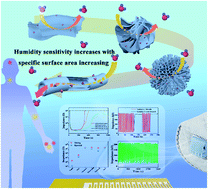Controllable construction of Ho2O3 nanomaterials with different dimensions (1D, 2D, and 3D) for real-time monitoring human breathing and body surface humidity detection†
Abstract
The morphological control of nanomaterials plays a crucial role in enhancing the properties of nanomaterials. Regulating the dimension of nanomaterials through simple synthesis has always been the focus of scientists, especially for the dimensional regulation of rare earth oxides. In this paper, a simple controllable solvothermal self-assembly strategy was used to obtain Ho2O3 nanomaterials with three dimensions (1D, 2D, and 3D) and four different morphologies. The formation process, morphology regulation and structure of Ho2O3 nanomaterials were studied. The Ho2O3 nanomaterials were applied to humidity detection for the first time. The ultra-thin porous Ho2O3 NS humidity sensor shows the best response to humidity among the four samples. Its impedance has changed by nearly four orders of magnitude when the humidity changed from 11–95% RH. The response time and recovery time are only 0.3 s and 6 s, respectively. And the sensor also exhibits excellent repeatability and stability for humidity detection. More important is that new applications of the humidity sensor are developed to test human breathing vital signs, body surface humidity and the moisturizing effect of skin care products. This work provides a new method for developing high performance humidity sensors to monitor human vital signs and detect the efficacy of moisturizing products.



 Please wait while we load your content...
Please wait while we load your content...